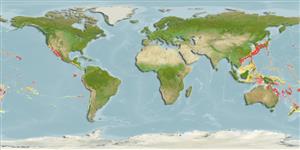Environment: milieu / climate zone / depth range / distribution range
بوم شناسي
دريايي نزديك كف زي; تغييرات عمق 85 - 510 m (Ref. 58302). Tropical
Western Pacific: confirmed to occur from Japan, Korea and the East China Sea south
to Taiwan.
Size / Weight / سن
Maturity: Lm ? range ? - ? cm
Max length : 22.3 cm SL جنس نر / بدون خواص جنسي; (Ref. 7434); common length : 15.0 cm TL جنس نر / بدون خواص جنسي; (Ref. 9137)
شعاع نرم باله پشتي (کل): 15-16; شعاع نرم باله مخرجي: 9 - 10; مهره ها: 41 - 43. This species is distinguished by the following characters: D 16, rarely 15; A 10, rarely 9; pectoral fin rays 11, rarely 12; vertebrae41-43; total gill rakers 20 or 21, rarely 19 or 22; lateral line scales 42-43, rarely 41; pyloric caeca 11; in males, dorsal fin is large anteriorly, the membranes deeply incised but none of the rays are filamentous, third or fourth rays longest, reaching 25.7% SL, decreasing in length to middle of fin with posterior rays progressively longer, reaching 19.5% SL, its posterior lobe reaching to or past adipose �n origin; in females, anterior end o fin lower, with membranes deeply incised and rays decreasing in length to middle of fin, lengths of subsequent rays subequal, posterior lobe reaching little more than half way to adipose fin; anal fin in males is relatively deep with posterior lobe approaching hypural crease in large individuals, smaller in females with posterior lobe reaching little more than half way to hypural crease; Males have prominent, large orange to red blotch or markings anteriorly and yellow spots posteriorly in dorsal fin, 3 broad bands on side with wide dark brown margins dorsally, wide yellow stripes on each lobe of caudal fin and white pelvic and anal fins the pelvic somewhat orange basally and anal with broad yellow stripe on basal half; females have orange to red spots scattered on dorsal fin, similar but less defined pattern on side, caudal fine with mottled yellow to orange pattern, similar pelvic fin but no yellow on anal fin (Ref. 94775j).
Found in sandy or muddle areas (Ref. 9137). Benthic (Ref. 58302). Can also be found at 30 m depths (Ref. 11230). A carnivore which feeds on fish and crabs (Ref. 9137).
Life cycle and mating behavior
بلوغ | تولید مثل | تخم ریزی | تخم ها | Fecundity | توزاد ( لارو)
Randall, J.E. and K.K.P. Lim (eds.), 2000. A checklist of the fishes of the South China Sea. Raffles Bull. Zool. Suppl. (8):569-667. (Ref. 36648)
وضعيت در فهرست قرمز IUCN (Ref. 130435)
خطر برای انسان ها
Harmless
استفاده انسانی
ماهي گيري – شيلات: تجاري
اطلاعات بيشتر
اسامي عاممترادفسوخت و سازشکارچیانسم شناسي بوم زيستيتولید مثلبلوغتخم ریزیSpawning aggregationFecundityتخم هانمو تخم
مراجعآبزي پرورينمايه آبزي پرورينژادهاژنتيكElectrophoresesوارثبيماري هافرآوریNutrientsMass conversion
ابزارها
گزارش های ويژه
بارگيری XML
منابع اينترنتي
Estimates based on models
Preferred temperature (Ref.
123201): 5.7 - 21.3, mean 15.2 °C (based on 146 cells).
Phylogenetic diversity index (Ref.
82804): PD
50 = 0.5020 [Uniqueness, from 0.5 = low to 2.0 = high].
Bayesian length-weight: a=0.00447 (0.00187 - 0.01067), b=3.12 (2.91 - 3.33), in cm total length, based on LWR estimates for this (Sub)family-body shape (Ref.
93245).
Trophic level (Ref.
69278): 4.0 ±0.66 se; based on food items.
جهندگی (Ref.
120179): متوسط, كمينه زمان لازم براي دو برابر شدن جمعيت 4/1 – 4/4 سال (Assuming tm=1-3).
Fishing Vulnerability (Ref.
59153): Low vulnerability (17 of 100).
